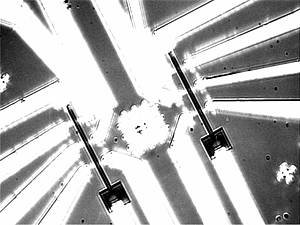SPINCURRENT aims to investigate and exploit the transfer of spin angular momentum from a polarised current to a domain wall in a ferromagnet. As well as involving beautiful and fascinating basic physics, this effect could be useful for writing data to high density non-volatile memories and performing switching operations in domain wall logic schemes.
 |
Domain Wall motion in permalloy nanowires imaged by SEMPA
(a) Topographic image of the device structure showing the Au contacts (white) and the four zigzag Fe20Ni80 wires (light gray) with square pads at the bottom.
(b) Magnetization configuration in a wire after magnetizing with a field pulse along the direction indicated by the arrow. White (black) corresponds to the magnetization pointing up (down) within the plane; a head-to-head wall is formed at the top bend, a tail-to-tail wall at the bottom.
(c) After injection of a single 10 µs long current pulse through this wire, both domain walls have moved in the direction of the electron flow as indicated by the arrow.
Reprinted from Phys. Rev. Lett. 95, 026601 (2005), copyright American Physical Society.
 |
Kerr Microscope image of Co/Pt nanowires
Co/Pt, with its perpendicular magnetisation, should be possible to engineer into low current domain wall motion devices. Here we show magnetic domain images of prototype devices as we work to control the initial nucleation and propagation of a domain wall.
 |
Ultra narrow domain walls
Stronger effects are expected as domain walls become more abrupt. We have developed methods for growing epitaxial ordered magnetic alloys that exhbit walls that a thinner than 10 nm. A magnetic force microscope image of the remanent domain pattern is shown below. We are currently working on patternig these structures into nanoscale devices.
Project Leader
- Christopher Marrows
University of Leeds, Faculty of Mathematics and Physical Sciences, School of Physics and Astronomy, Leeds, UK
Principal Investigators
- Rolf Allenspach
IBM Research Division, Rüschlikon, CH - Michael Coey
Trinity College, School of Physics, Dublin, IE - Vladimir Falko
Lancaster University, IENS, Physics Department, UK
Associated Partners
- Michel Viret
CEA Saclay, Gif-sur-Yvette, FR - David Williams
Hitachi Cambridge Laboratory, Cambridge, UK
Collaborator
- Dafiné Ravelosona
Institut d'Electronique Fondamental, Université de Paris Sud, FR

